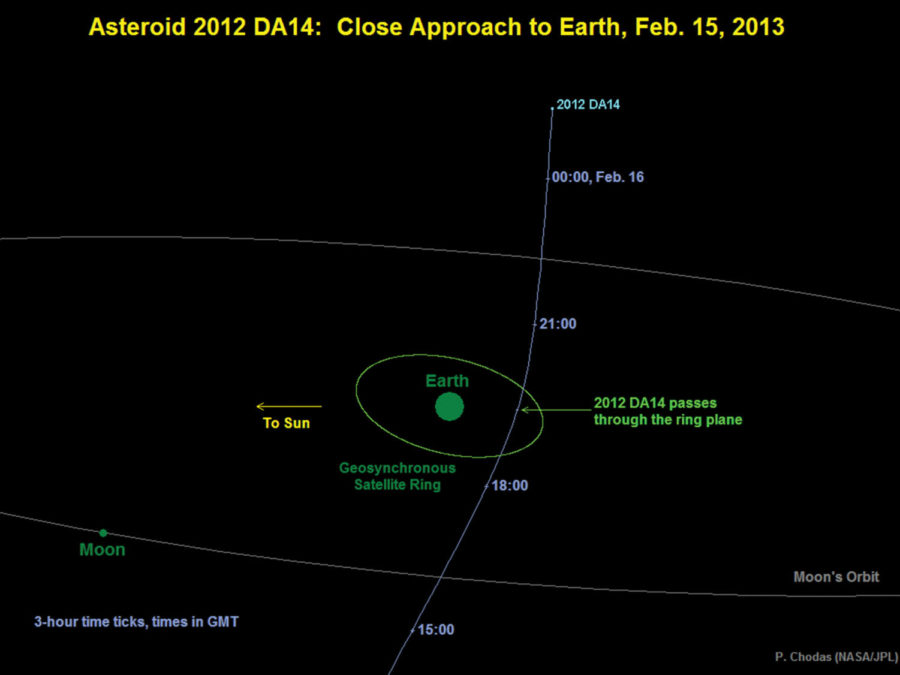Timberlake: It’s a bird, it’s a plane, it’s an asteroid!
The diagram shows where asteroid 2012 DA14 will pass on Feb. 15.
February 15, 2013
June 30, 1908, was a rather eventful day in an otherwise uneventful forest in Siberia, Russia, when a meteor nearly a football field in size exploded only a few miles above Earth’s surface.
The “Tunguska event” went almost completely unnoticed thanks to its isolation from the rest of the world, even though it impacted Earth with an energy level equivalent to roughly 15 megatons of TNT —or 1,000 times as powerful as the thermonuclear detonation over Hiroshima, Japan.
The Tunguska meteor leveled more than 830 square miles and would have measured more than 5.0 on the richter scale — and was almost identical in characteristics to the asteroid passing a record close proximity to us today, Feb. 15th, named “2012 DA14”.
Asteroid 2012 DA14 is a little less than a football field in diameter and weighs an estimated 130,000 tons. It will pass within geosynchronous orbit at an altitude of about 3.5 Earth radii — 5,000 miles less than the satellites — and will be traveling 18,000 miles per hour, more than 23 times the speed of sound.
If this asteroid were to enter our atmosphere and become a meteor, it would be almost laughable for me to say it would be a bad day.
Have no worries, though, there is zero chance for 2012 DA14 to hit us, even on any return trip within the next 100 years.
As NASA Jet Propulsion Lab’s newest volunteer ambassador for Iowa, I will regularly make an effort keep you up to date on the latest information and research to come out of NASA. Clarified in the paper, any opinion I hold is independent to that of NASA.
With that said, it is unlikely you will be able to see the asteroid with the naked eye. If you wish to see it, it will require a mounted pair of binoculars positioned to catch the asteroid traveling from the southern evening sky to northern morning sky at about 1:24 p.m. The asteroid can be viewed via live feed from one of NASA’s telescopes at http://www.nasa.gov/multimedia/nasatv/ustream.html
2012 DA14 was discovered by the LaSagra observatory in southern Spain on Feb. 23, 2012. This is almost exactly one year before the asteroid’s passing. Suppose it was calculated to be an impact like the one in Tunguska Forest.
Is one year enough time to prepare if 2012 DA14 were on an orbital path destined to impact us?
An asteroid this size is not big enough to decimate a large region of the world, but it is big enough to decimate a metropolitan area. Even though an asteroid is far more likely to impact water than land, let alone a highly populated area, things like this would need to be considered. Would it be feasible to organize a team to send out a spacecraft to intercept and divert said asteroid? Or would it be better to calculate its impact region and evacuate anyone within the effective impact radius?
If the asteroid were anything like 2012 XE54, discovered Dec. 9, 2012 — two days before passing Earth within the moon’s orbit — then there isn’t much we could do but evacuate as many as possible and tell the world to hunker down. Even though 2012 XE54 was not big enough to do considerable damage if it hit us, it still shows the owl-like stealth of these rocks and how well they fly under the radar.
As far as I can discern, a future asteroid impact is the only natural disaster humans have the capability to avert. It’s also the only known natural disaster capable of wiping us out just as it did the dinosaurs 65 million years ago.
NASA and other private corporations should be well-funded such that scanning the local galaxy becomes simplistic and proficient enough to spot lethal asteroids well before they spot us, and possibly already have tested and proven asteroid diverting technology.
Quoted more than once in my columns, Aldous Huxley said, “That men do not learn very much from the lessons of history is the most important of all the lessons of history.” The sad reality is that it takes a massive disaster to occur for us to do anything about it on the come around, and even then we are lax. Let us consider the implications of said near-misses and start appropriating resources toward a solution.
——————————————————————————————-
Ian Timberlake is a senior in aerospace engineering from Chicago, Illinois.







